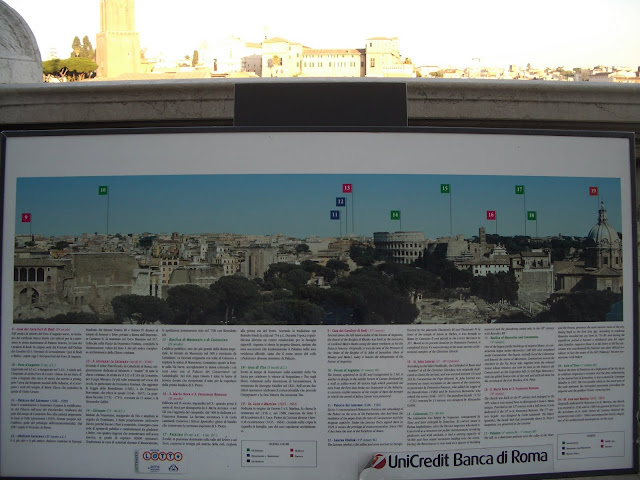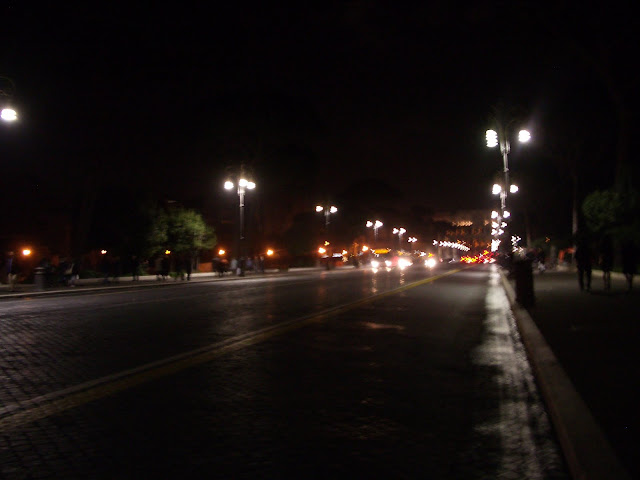 First I walked up the stairs of the monument pictured at the right to get a good view. I actually did that before I entered the museum but lets not get into details here. They had a series of posters showing you a picture of the view you were seeing and then labeling the important buildings. And then after that I went to the roof, where the winged chariots are.
First I walked up the stairs of the monument pictured at the right to get a good view. I actually did that before I entered the museum but lets not get into details here. They had a series of posters showing you a picture of the view you were seeing and then labeling the important buildings. And then after that I went to the roof, where the winged chariots are. Here is the poster, which you should keep in mind for a vista picture below. Zoom in on this if you want.
This is Trajan's Market, from the ancient Roman times. The thing I like about Roma is the different historical levels all at one. This includes ancient Roman Imperial times, the Medieval times, the Renaissance, the Counter-Reformation, the Baroque period, the Fascist period, and finally modern Italy (good luck finding that one, because there are no skyscrapers in Rome). According to the internet,is Trajan's Market is a large complex of warehouses, offices, and shops, build between 107 and 110 AD where Romans would meet to purchase goods, conduct business, and generally have a good time. It was built by Emperor Trajan's favorite architect, Apollodorus of Damascus, who designed the Forum which borders the market as well. 

Also, here's a bird standing right above the sign shown earlier, with Trajan's market in the background barely.
And of course a closeup of the bird. It wasn't scared of me so I got kind of close and took this picture and another one just like it. You can see Trajan's Market behind him, where his ancestors probably flew as well.
After this I actually went up to the elevator to the roof the monument, or the "Wedding Cake" as the Romans affectionately call it. These are some of the best pictures of Roma that I took because I could literally see the whole city. These views are not as good as those from the top of Villa Borghese and on the hills atop Trastevere (sorry, no pictures) because those are clear unobstructed views... Andiamo! (Here we go!)
Here is one of the two Winged Chariots put in by (guess who?) Mussolini, who put in everything in Rome because he was obsessed with Rome. However the feelings were not mutual and Mussolini was eventually executed. Nevertheless, a lot of his stuff lives in, especially right here in the heart of Rome. However we are also looking in the Northwest direction, which is the direction of the Vatican and where I lived while I was in Rome. You can see the dome of St. Peter's (however you can't see Residence Candia unfortunately) and if you follow the straight path called Viale Della Conciliazione (made by Mussolini, which leveled numerous historic buildings, including Raphael's palace), you can see Castel Sant'Angelo at the right edge just below the horizon. Its the cylinder castle building. Look back to one of the first posts to see what that looks like.

Here is the view shifted slightly to the right. Lets follow along now, don't get lost.

The main street leading down is Via del Corso I believe. The grass right before that on the right is Piazza Venezia, one of the biggest piazzas in Roma. It is a roundabout for traffic and a tourist herding spot.
This is Via del Corso which leads to Piazza del Popolo which has an obelisk. As mentioned earlier, the model capitol hill leading to an obelisk in a straight rode in Washington D.C. came from this.

We shift to the right (east) a little more to see more of Roma. It is worth noting that Mussolini tore down everything surrounding this monument to make it stand out. By that I mean that all the open road and space you see besides Via Del Corso was all buildings after building. All gone.

A view of the Colosseum and the straight road from that to the Campidoglio, the Via dei Fori Imperiali. When you see a straight road in Rome that connects major monuments, you know it was created by Mussolini. So yeah, yay fascism...
Another similar view. I can never get enough...
Here is a view of the Colosseum and the Roman Forum ruins. Caesar, Augustus, and all the Senators lived here on the Capitolino. All the buildings were very tall back in the day so imagine grand marble buildings all at least 10 stories long with all the riches of the entire empire being funneled here.

Here is a closeup of where I lived with the dome of St. Peter's and Castel Sant'Angelo. Of course there is a straight road connecting them, the Viale della Conciliazone, so I'm sure you can guess who made that.

Here is a (slightly blurry) view of this road from the street providing the il colosseo as the strada con fondale, or the road with a backdrop. It reminds me a bit of Paris.
Moving rightward from the Forum ruins we come across another familiar aspect of Roma. This of course is the Theatre of Marcellus (the mini Colosseum) and the rione Ebraico. You can see the synagogue of Roma right under the glare.

Well this bird is telling us that this post is over... ciao!









No comments:
Post a Comment